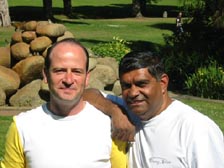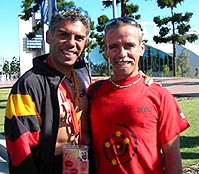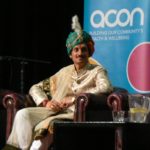How fine is this! A very much ignored and under-served LGBT population is receiving recognition in Australia.
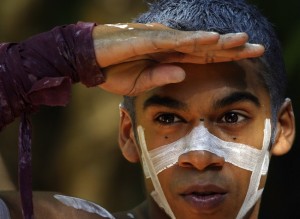
Also see this report:
Aboriginal Queers
(From: http://www.globalgayz.com/gay-australia-and-gay-games-vi-2/279/)
Appealing and wonderful as the scene was, the folks I wanted to interview in Melbourne were rather unique: Indigenous Aboriginal homosexuals. Prior to arriving for the Games, I hadn’t thought much about this segment of our community. Then at the opening ceremony I saw a contingent of dark-skinned athletes walking and dancing behind their scrawled ‘Indigenous Australians’ banner. A few days later at the Olympic Aquatics Center I met three Indigenous team members, and they happened to be from Melbourne. So a week later on a sunny (85 degrees F) afternoon I sat in Melbourne’s sylvan Victoria Park with Ronald and Grant, partners for four years. Ronald is an out and outspoken Indigenous gay professor of Indigenous Studies at the Royal Melbourne Institute of Technology. He also recently ran for election to the Aboriginal and Torres Strait Islander Commission as the first openly gay candidate.(See more about this campaign at: http://www.eniar.org/news/Johnson.html)
Under the shade of a huge eucalyptus tree we spoke about being gay in the Aboriginal culture—or what was left of it.
|
|
The white history of Australia began with invasion and became theft. The Aboriginal culture that had developed for eons in pre-Australia was declared barbaric by the invading British who almost succeeded in a malicious intention to eliminate the black face from the new colony–thanks to the invention of fast loading rifles.
For much longer than the British Empire had developed in Europe these native people had populated the continent, developing rituals, communities, beliefs, language and food gathering methods. Although diverse and separate tribes (families) were scattered across the land, there were common elements such as respect for the inherent nature of the land and human life as it was expressed in each individual. A dual revered spirit, one immortal one mortal, dwelled in human and non-human alike, in the forests, rivers, sky, animals and seasons.
“The history of Australia Aborigines flies very far back into history—60.000 years. But that history was interrupted with the invasion of the white Europeans starting in 1788 with their prisoners and guns and fear and ignorance,” said Ronald looking up at a nearby giant tree as if to contemplate the age of things. “Then everything changed for the worse. Native black people were considered savages to be overruled. At first they tried annihilation which didn’t work—but almost did.
|
|
Then came the apartheid of segregation for a few generations as natives were herded into Christian missions or onto confined reservations. When that broke down the government tried assimilation for half of the twentieth century. Starting 1918 and lasting until the 1960’s, the white government gave itself the authority to remove Aboriginal children from their mothers if they suspected the father was not also Aborigine. They took thousands of these young children away from their homes, put them in foster homes or institutions and refused to let them learn their native language and culture. We call them the ‘Stolen Generation’ who grew up separated from their heritage.”
It was not until Prime Minister Gough Whitlam in the 1970’s finally realized the great offense they were committing. He was the first head of the white government to show some respect for the culture that had preceded him. Money was allotted for Indigenous law and land reforms. Clumsy and inadequate attempts were made to establish Indigenous governing organizations but they were wasteful since only a few privileged Indigenous clans benefited and most others remained poor and destitute. “These anointed few were even appointed ‘kings’ or ‘queens’ in an effort to build a hierarchy of community but it was also disastrous. These were phony ‘Oreo’ leaders,” Grant added with a smirk of disdain toward such callous and inappropriate policies.
Today the legal situation is better, but only for some: the unemployment rate for Aborigines is still 38% The overall result of white rule has been the decemation of Indigenous culture, language and their family-clan way of life. “Our history was wiped out along with so many of our rituals and ceremonies. All-important connections between clans have been broken. So reconstructing this history is very difficult. There are no written documents since ours was a story telling culture.”
Not surprising is that any stories of native homoerotic or homo-themed rituals were wiped out by the moral Christian rulers who saw any kind of male-male intimacy as abnormal. “We have only some glimpses of pre-Christian clan rites of passage where young men (13 years old) ‘slept with uncle’ (teachers, mentors) the night before initiation/circumcision rites of passage into manhood. Such a gathering was called a ‘corraboree’. I suspect there was a physical or sexual component to this ceremony by which manhood was passed on from older to younger men,” said Ronald.
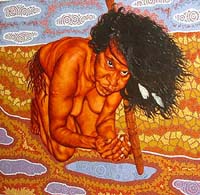 Any written or oral Aboriginal history was voided by the invaders so we will never know for sure how a native tribe or clan member was treated who was attracted to their own gender. (One can only guess that, similar to the Native American tribes, an androgynous role was allowed for such unique members. The term ‘berdache’ allowed for an effeminate Native American male to be raised as a girl and to perform female roles–or (?) a tomboy girl to move among the men.)
Any written or oral Aboriginal history was voided by the invaders so we will never know for sure how a native tribe or clan member was treated who was attracted to their own gender. (One can only guess that, similar to the Native American tribes, an androgynous role was allowed for such unique members. The term ‘berdache’ allowed for an effeminate Native American male to be raised as a girl and to perform female roles–or (?) a tomboy girl to move among the men.)
Another (unclear) tradition is reported from the Palm Island cultures on the north coast where Indigenous communities allowed for ‘sister girls’, an affectionate term among women for men who lived as (transvestite) women in the larger tribe. Ronald said they were called ‘Fahafines’, but he was not sure. There seems not to have been a single term within Aboriginal communities, past or present, which covered lesbians, gay men and sistergirls. Some communities are reported to have used terms like ‘Two-one’ to show their view that two spirits (both male and female) lived within one person.
As a result of this multigenerational cultural genocide, today Aboriginal families react to homosexuality like their Christian overlords conditioned them. Ron went on: “It is seen as a moral deviation and many of us are afraid to come out to our families. It’s painful to be separated from your family, but many of them don’t understand. I think that pre-1788, when the first white people came, that homosexual feelings and activity were simply seen as another form of nature, as something that was there from the beginning of the Dreaming. Every member of the clan had spiritual being and queer members may have had some special spiritual role, but that’s lost.”
Kerrianne Cox, Indigenous Lesbian Spirit
In addition to Ronald’s comments about homosexuality and the Aboriginal tradition, I spoke to the well-known Indigenous singer-songwriter Kerrianne Cox who performed numerous concerts during the Gay Games and several festivals across Australia afterwards. I met up with her in Adelaide where I asked her similar questions about the role of the homosexual in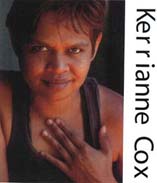 Indigenous clan life. She also agreed that so much destruction of her culture makes it hard to be sure if there was a special role for our people.
Indigenous clan life. She also agreed that so much destruction of her culture makes it hard to be sure if there was a special role for our people.
But Kerrianne is an intuitive woman who feels her culture within her heart; she feels her lesbian self in her soul. It’s from this deep source that she composes her music. “We have been separated from our ‘Dreaming’, our history. But I think gay then was a normal thing. There was Man’s Law and Woman’s Law and there were roles for each person with spiritual connections to the Dreamland of our ancestors.
In my songs, as a Native woman, a lesbian, I feel I am delivering my ancient culture to modern life. I don’t know exactly how that works, but I can feel this connection. You know in our culture these connections are very important. They are the life-blood that gives us a meaning, a history and a future… I feel a joy in my heart, from my being, my clan to the world. We have been pushed to the curb but I tell people in my music that we can be strong, we can be black, we can be women and proud…”
And before long she was off, with her lover Dorothy, to another concert in another city.

